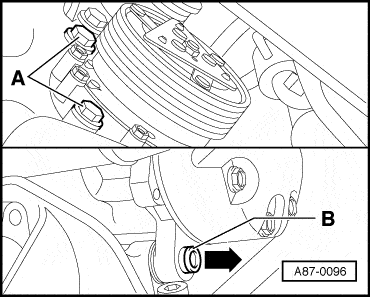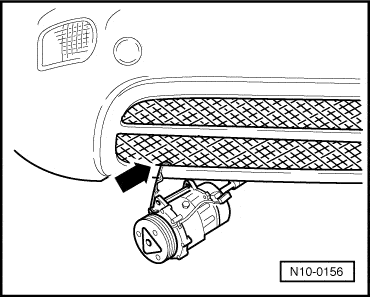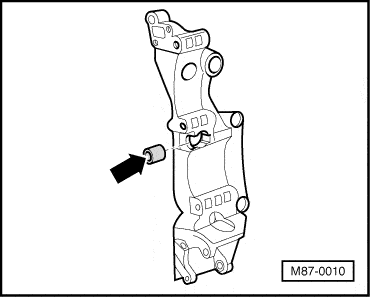I am having a air conditioner problem. I cranked car, air was cold then went warm. The compressor making buzzing/humming noise. So tried recharge with Freon but did not work. So I was wondering could it be that the compressor is gone or bad? I checked fuses and they was working good. need help asap… this 2002 vw beetle 2.0 engine
How to Check Air Conditioning
You will find the above links to some useful diagnostic information that will help you narrow down the root of the problem. Removal procedure of the Air Conditioning Compressor is provided below.
Something to keep in mind would be the FREON capacity of your car. Overfilling the refrigerant can and will cause the system to blow hot and possibly lock up the A/C compressor. Also, the system must be evacuated and a vacuum pulled on the system before filling with Freon.
Air Conditioning Capacity
Freon Capacity 2002 VW Beetle: 25 Oz. R-134A
A/C Refrigerant System, Testing with Pressure Gauges
Due to the constant temperature/pressure relationship of refrigerant R-134a, approximate high-side system temperature can be determined based on system pressure.
Pressure gauges may have one or more temperature scales in addition to the pressure scale. Since various refrigerants have different temperature/pressure relationships, each gauge is specific for a particular refrigerant.
Refrigerant System, Switched On, Measuring Pressure and Temperature
Use the A/C refrigerant high-pressure gauge to measure high pressure between the compressor and restrictor (including condenser) with the A/C switched on.
Use the A/C refrigerant low-pressure gauge to measure low pressure between the restrictor and the compressor inlet (including evaporator) with the A/C switched on.
The temperature displays of the low- and high-pressure gauges apply only to a portion of the low- and high-pressure sides. The low-pressure gauge displays approximate temperature between the restrictor and evaporator outlet. The high-pressure gauge displays approximate temperature between the compressor outlet and restrictor.
- The temperature/pressure relationship only holds true when the refrigerant system contains liquid and vapor, but not when it contains only gas. In the gaseous state, the temperature is approximately 10-30°C (18-54°F) higher than indicated on the pressure gauge.
Refrigerant System, Switched Off, Measuring Pressure and Temperature
Due to the constant temperature/pressure relationship of R-12 and R-134a, approximate temperature in a closed container or in a switched-off A/C system can be determined based on its pressure.
If the temperature displayed on a gauge is lower than the actual temperature of the refrigerant, the refrigerant container or system is empty (discharged).
- The temperature/pressure relationship only holds true when the refrigerant system contains liquid and vapor, but not when it contains only gas. In the gaseous state, the temperature is approximately 10-30°C (18-54°F) higher than indicated on the pressure gauge.
A/C Compressor, Removing Downward
- For some work on the vehicle, the A/C compressor can be removed without opening the refrigerant circuit (for example, removing and installing the engine, removing and installing the A/C compressor bracket).
- Do not bend or stretch lines or hoses as compressor and refrigerant lines/hoses may be damaged.
- If A/C compressor must be disconnected from refrigerant circuit, vehicle must be taken to specialist workshop with specially trained personnel (authorized service shop for A/C systems) as the refrigerant must be drained first using the A/C Service Station VAS6007A. Disconnecting and reconnecting refrigerant lines from A/C compressor.
- For the following procedure, the battery ground cable must be disconnected. Determine whether a coded radio is installed. If so, obtain anti-theft coding beforehand.
►Remove ribbed belt.
Gasoline Engines and Diesel Engine ATD:
►Remove the power steering pump from the bracket.
All Engines:
►Loosen bolts A for A/C compressor approximately two rotations and drive back threaded sleeves B in the direction of the arrow. Remove bolts.

►Remove A/C compressor with connected lines out of bracket.
- With 2.3 L engine installed, lock carrier must be brought into service position first.
- For vehicles with boosted cooling system, right auxiliary fan must be removed and radiator must be protected from damage using cardboard.
►Mount the A/C compressor in such a way so that the refrigerant lines/hoses are not burdened.

- Protect bumper from damage using adhesive tape.
A/C Compressor, Installing
- For some work on the vehicle, the A/C compressor can be removed without opening the refrigerant circuit (for example, removing and installing the engine, removing and installing the A/C compressor bracket).
- Do not bend or stretch lines or hoses as compressor and refrigerant lines/hoses may be damaged.
- If A/C compressor must be disconnected from refrigerant circuit, vehicle must be taken to specialist workshop with specially trained personnel (authorized service shop for A/C systems) as the refrigerant must be drained first using the A/C Service Station VAS6007A. Disconnecting and reconnecting refrigerant lines from A/C compressor.
- Make sure that version A, sleeve for A/C compressor arrow is installed for vehicles with A/C compressor bracket.

►Before installing A/C compressor, slide sleeve B completely into hole in A/C compressor.

►Attach bolts A and tighten to 45 Nm.
►Reinstall ribbed belt.
- When installing ribbed belt, be sure that it is seated correctly on ribbed belt pulley.
Perform remaining installation operations in reverse order of removal.
